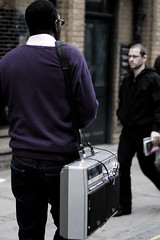
Sometimes, I learn more about photography when I teach about photography, than when I learn about photography. Bear with me, it does make sense, honest.
I have one friend – Daniela – who is a n00b at this whole photography things. Some of the questions she asks, and some of the comments she makes, sound like stupidity in my ears. ‘Of course not’, I want to burst out… And yet… that’s a learning moment for me. What is ‘obvious’ to me isn’t necessarily obvious to others – especially if you’re just trying to come to terms with photography and how it all fits together.
Anyway, Daniela was recently in Belgium, and had a go at some street photography. I’ve written about Street Photography many times before: A shot at Street photography, Katie Cooke’s The return of Street Photography, Brad’s Street Photography and the Law, Street Photography in Montreal, Prime Lenses, and why you need one, Oi You! no Pictures! and it’s also mentioned in my article about insuring your photography gear.
What I had never stopped to think, however, is how a beginning photographer looks at street photography. Daniela offered some insights…
When I was Belgium I had a go at some street photography. I wasn’t entirely happy with what I produced, but it doesn’t mean to say that I won’t try again. In fact, I think I’m rather looking forward to having another go. These are some thoughts on the experience, from someone who is not nearly as talented – technically or artistically – as the Photocritic. I’m not sure if my ramblings are of any help to you, but they might be….
Aside from the obvious, being a camera, what you need most for street photography is confidence. That’s not confidence in your photographic abilities, it’s confidence to walk around holding however many pound’s-worth of camera equipment it is that you own and to take photos. If you don’t have the confidence to point and shoot, you won’t get the pictures that you want. The more photos that you take, the better you’ll become. That’s obvious. So don’t be put off by your attempts not working. They can only work if you actually try it.

Sometimes you catch the most amazing sights on the streets - like this guy with his 1970s ghetto-blaster (click image for bigger)
Make sure that you know the rights and wrongs of taking people’s photographs in public places. If someone stops you, you need to be able to respond confidently and accurately about what you’re doing. Even if you don’t know what you are doing, be confident and act as if you do. It goes without saying that being polite and respectful is something you should be doing, and be careful taking photos of kids.
As much as I know you are anti-automatic settings on DSLR cameras, when you start out it can be helpful to use the automatic setting. Until you are accustomed to it, it’s easier to let your camera do the hard bit whilst you’re getting to grips with the concept of street photography. When you’re more experienced and more comfortable with what you’re doing, you’ll want more control over what you’re shooting and you’ll have a better feel for what you need to do. Don’t overwhelm yourself initially with the technical aspects, concentrate on getting a shot.
Daniela first wrote for Photocritic with her Teaching Photography to a 5-year-old article.
Do you enjoy a smattering of random photography links? Well, squire, I welcome thee to join me on Twitter - Follow @Photocritic
© Kamps Consulting Ltd. This article is licenced for use on Pixiq only. Please do not reproduce wholly or in part without a license. More info.

